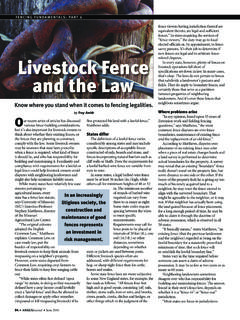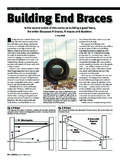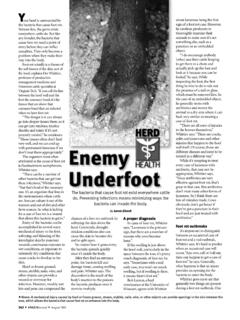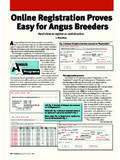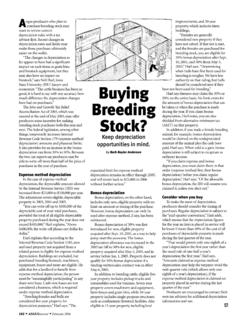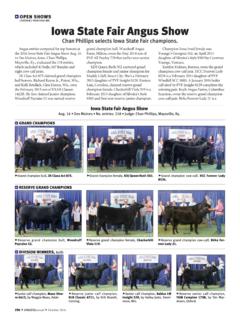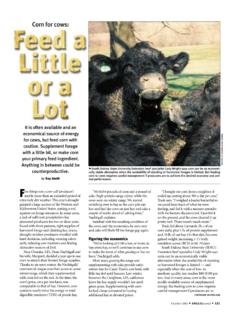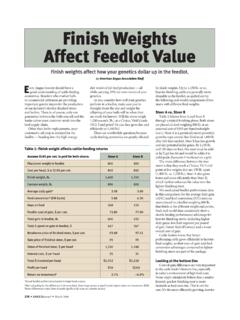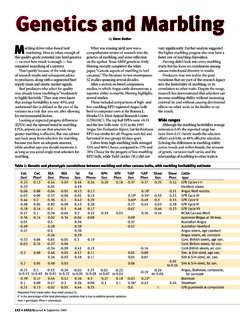Transcription of Or at least bull-deterring fences can be made of ...
1 OK, when this article was given a title it was with tongue planted firmly in cheek. Anyone who has kept a bunch of bulls around for any length of time knows there is no such thing as a bull -proof fence . One bull might not be so hard to keep contained, but putting two or more together results in fighting to establish and re-establish the pecking order. Sooner or later, they re going to tear up some fence , regardless of its on. This writer has seen photographs of corral fences consisting of rows of crushed and stacked car bodies, and others constructed from hundreds of used truck tires. Those fences might be bull -proof, or nearly so. However, the use of those particular building materials prompted complaints from neighbors and other folks who didn t find the fences aesthetically pleasing or accused the fence owners of mishandling waste materials. But that s another story. For the purpose of this article, we ll concentrate on bull - deterring fences made from more common and, perhaps, more practical the pastureMost producers know how cattle often test their boundaries while trying to sample whatever looks greener on the other side.
2 When a big bull reaches over, under or through a traditional barbed-wire fence , something is going to give. According to fencing expert Bob Kingsbery of Frisco, Texas, the answer is to make the fence more intimidating. With a traditional fence , that means using more wood and wire, Kingsbery says. Or producers can apply the fear factor an electric fence offers. Kingsbery has built many, many miles of fence , starting as a youngster on a south Texas ranch stocked with wily Brahmer cattle. Professionally, he has served as a fencing and animal behavior consultant, as well as a sales representative or consultant for several companies that manufacture and market fencing products, including Gallagher/Snell Inc., American FarmWorks (now known as Zareba Systems), and, most recently, Dare has authored three books and more than 100 magazine articles on fencing , livestock management and grazing techniques. In addition to conducting seminars on fencing technology, he has provided expert opinion and testimony for court cases involving livestock-related accidents, livestock fencing , animal behavior and livestock to Kingsbery, fence height makes a big difference.
3 Many pasture fences 72 n AngusJournal n March 2010 fencing FUNDAMENTALS: PART 5Or at least bull - deterring fences can be made of traditionally available Troy SmithPhOTO by ShAUNA ROSE hERMEL fencing FUNDAMENTALS: PART 5 March 2010 n AngusJournal n 73have the top wire fastened to posts at a height of 42 to 54 inches (in.). To deter cattle, and especially big bulls, from reaching over the fence , he recommends setting the top wire of perimeter fences at a height of 54 to 60 in. Use no fewer than five strands of barbed wire, spaced no farther than 12 in. apart, to discourage cattle from reaching between the wires, and place the bottom wire no higher than 18 in. above ground level. A good option, especially for small lots, is a combination of field fencing (what some producers refer to as woven wire) and barbed wire. It s more expensive, but 48-in. field fencing topped with two strands of barbed wire makes a pretty good physical barrier. More posts set closer together add stability and more bounce-back if cattle hit the fence .
4 And with posts, bigger is better, Kingsbery says. My favorite approach is to combine physical barrier and fear barrier by running one or two strands of electric fence wire or poly-tape around the inside, he says. Position one wire at the shoulder height of the animal to be controlled, and one wire along the top of the fence for best results. Permanent electric fence constructed with high-tensile wire continues to gain acceptance among producers. Generally, multiple wires are used for perimeter fences , but division fences between pastures or paddocks may consist of two or even one says the most important element of any electric fence is the grounding system. He recommends a system consisting of a minimum of three 6-foot (ft.) galvanized ground rods spaced 10 ft. apart. Use a fence charger (energizer) with enough power to control livestock, one that is rated for at least 2 joules (J) for 100 acres or less, and at least 4 J for larger acreages. Use high-quality insulators, and make good connections using insulated cable and clamps designed for electric reminds producers that attention to maintenance is essential, regardless of the type of fence used.
5 He advises daily checks of electric fence , with particular attention to voltage. Barbed-wire fences should be checked routinely, broken posts replaced and wires kept facilitiesPlenty of options for constructing corrals and working facilities are available. The ultimate cattle-working system, in many producers minds, is constructed of heavy steel pipe, with posts set in concrete. Alternatives include used highway guardrail or wooden rails or planks fastened to heavy, deeply set suggests producers consider using the stoutest materials they can afford, especially for facilities that see frequent use. Again, adequate height and a visible top rail are important to deter bulls from trying to jump over the fence . Some producers do get along surprisingly well with sorting pens made from posts and wire or mesh panels, topped with a single rail and maybe a bumper rail fastened midway between top and bottom. Success with this kind of setup usually can be credited to an understanding of cattle behavior and savvy handling technique.
6 Producers will have far less trouble and face fewer fence repairs when their facilities are designed for ease of cattle flow, Kingsbery says. And there s really no substitute for good, low-stress cattle handling practices. Editor s Note: We re going to publish Part 5 of our series on fencing fundamentals a little out of order to match it with the bull Book theme of this issue. Watch for parts 3 and 4 of the series in upcoming issues.
